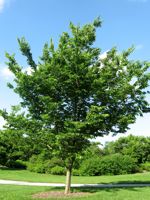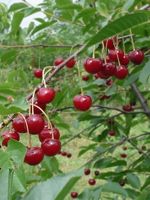Mon-Fri 9am - 5pm Mountain time
Common Hackberry vs DArtagnan Sour Cherry
Celtis occidentalis
Prunus cerasus dArtagnan
NOT AVAILABLE THIS SEASON - MIGHT RETURN
The Common Hackberry is a medium-sized deciduous tree that resembles the American Elm but is immune to Dutch Elm Disease. They are versatile and can adapt to a variety of growing conditions.
It produces purple-red, berry-like fruit with a large seed in the center. Both the sweet flesh, which tastes similar to dates, and the crunchy seed are edible. The fruit remains on the tree throughout the winter, offering a valuable food source for birds and other wildlife.
The Common Hackberry can also be a great addition to a pollinator garden. The tree itself is a host for the larvae of several butterfly species and the flowers provide a source of pollen and nectar.
The D'Artagnan Cherry is a cold-hardy sour cherry that produces small, sour cherries that are sweeter than other varieties. It typically produces high yields that are ready for harvest in early August. The cherries are good for fresh eating, baking, or preserves. It is comparable to the Romance series cherries, but has a typically shorter form.
The D'Artagnan Cherry is from the new Musketeer Series from the University of Saskatchewan. Cross pollinates well with the Romance series such as the Romeo or Juliet sour cherry.

